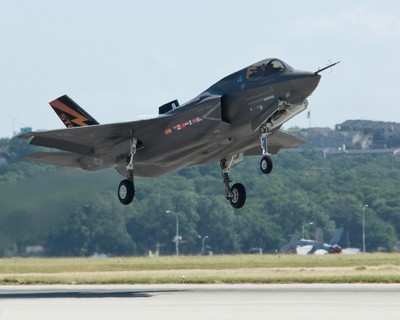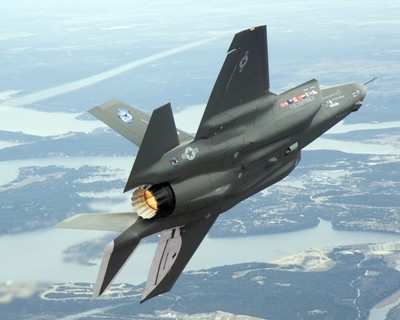Second Of Planned 19 Development Aircraft
With test pilot Graham Tomlinson at the controls, the short
takeoff/vertical landing (STOVL) Lockheed Martin F-35B Lightning II
streaked into blue Texas skies Wednesday, marking the first flight
of an aircraft that will provide a combination of capabilities
never before available: stealth, supersonic speed and STOVL basing
flexibility.

Tomlinson, a former Royal Air Force Harrier pilot now employed
by BAE Systems, performed a conventional takeoff at 1017 CDT from
Lockheed Martin's Fort Worth facility. As planned, all initial
F-35B flights will be made using conventional takeoffs and
landings, with transitions to short takeoffs, hovers and vertical
landings beginning early next year.
Tomlinson guided the jet to 15,000 feet and performed a series
of handling tests, engine-power variations and subsystems checks
before landing at 1101 CDT. "A great team effort led to a relaxed
first flight, with the aircraft handling and performing just as we
predicted based on STOVL simulator testing and flying the F-35A,"
Tomlinson said.
The F-35B, known as BF-1, becomes the second Lightning II to
enter flight test, preceded by the conventional takeoff and landing
(CTOL) F-35A, which first flew in December 2006 and has completed
43 flights. The F-35B that flew Wednesday is the second of 19
System Development and Demonstration aircraft and the first to
incorporate new weight-saving design features that will apply to
all future F-35 aircraft.
Though nearly identical in appearance to the F-35A, the F-35B
incorporates a counter-rotating shaft-driven lift fan positioned
directly behind the cockpit. The lift fan, produced by Rolls-Royce,
is turned by a drive shaft from the F-35's massively powerful
single engine, which features a swiveling rear exhaust nozzle that
vectors thrust downward during vertical flight.
The lift fan, engine and stabilizing roll ducts beneath the
F-35B's wings combine to produce 40,000 pounds of lifting force.
Converting the F-35B from STOVL to conventional flight and
vice-versa requires only the push of a button by the pilot. The
system otherwise operates automatically.
"We're absolutely convinced that this aircraft is going to only
further enhance what is a tremendous asymmetric advantage that we
hold in terms of controlling the air, taking advantage of
intelligence, surveillance and reconnaissance capabilities,
multi-sensor capabilities, and the ability, if need be, to drop a
bomb in a precision strike," said Gen. James Conway, Commandant of
the U.S. Marine Corps.
Three versions of the F-35 will be produced. The F-35A CTOL
variant will operate from conventional runways; the STOVL F-35B
will fly off small ships and near front-line combat zones; and the
F-35C carrier variant (CV) will be designed for catapult launches
and arrested recoveries aboard the US Navy's large aircraft
carriers.

The F-35B will be the first of the three Lightning II variants
to achieve Initial Operational Capability, beginning with the
Marines in 2012. The STOVL variant also will be used by the United
Kingdom's Royal Air Force and Royal Navy, and Italy's Air Force and
Navy. With the capability to operate from a variety of ships or
austere runways, the F-35B can deploy closer to shore or near front
lines, shrinking distance and time to the target, increasing sortie
rates and greatly reducing the need for support assets.
 ANN's Daily Aero-Linx (04.16.24)
ANN's Daily Aero-Linx (04.16.24) Aero-News: Quote of the Day (04.16.24)
Aero-News: Quote of the Day (04.16.24) Airborne 04.10.24: SnF24!, A50 Heritage Reveal, HeliCycle!, Montaer MC-01
Airborne 04.10.24: SnF24!, A50 Heritage Reveal, HeliCycle!, Montaer MC-01 Airborne 04.12.24: SnF24!, G100UL Is Here, Holy Micro, Plane Tags
Airborne 04.12.24: SnF24!, G100UL Is Here, Holy Micro, Plane Tags Airborne-Flight Training 04.17.24: Feds Need Controllers, Spirit Delay, Redbird
Airborne-Flight Training 04.17.24: Feds Need Controllers, Spirit Delay, Redbird




